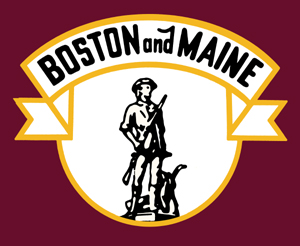
The Boston and Maine Railroad was a U.S. Class I railroad in northern New England. Originally chartered in 1835, it became part of what was the Pan Am Railways network in 1983.

The Maple Leaf is an international passenger train service operated by Amtrak and Via Rail between Pennsylvania Station in New York City and Union Station in Toronto via the Empire Corridor. Daily service is offered in both directions; the 544-mile (875 km) trip takes approximately 12 hours, including two hours for U.S. or Canadian customs and immigration inspection at either Niagara Falls, New York, or Niagara Falls, Ontario. Although the train uses Amtrak rolling stock exclusively, the train is operated by Via Rail crews while in Canada and by Amtrak crews in the United States. Service began in 1981.
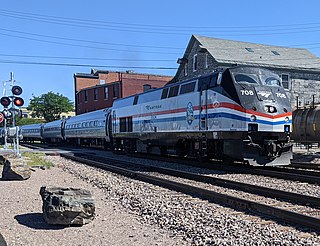
The Ethan Allen Express is a daily passenger train operated by Amtrak in the United States between New York City and Burlington, Vermont, via Albany, New York. One daily round trip is operated on a 310-mile (500 km) north–south route with a 7-hour 35 minute scheduled running time. The train is subsidized by New York and Vermont for the portion north of Albany. It is named for Vermont cofounder and American Revolutionary War hero Ethan Allen.

The Adirondack is an intercity rail passenger train operated daily, partially along the Empire Corridor, by Amtrak between New York City and Montreal. Trains take approximately 11 hours to travel the 381 miles (613 km) route through the scenic Hudson Valley and along the eastern border of the Adirondack Mountains. Operation of the Adirondack is supported by the New York State Department of Transportation and Via Rail. Service was suspended in March 2020 due to the closure of the Canada–United States border in response to the COVID-19 pandemic, resumed in spring 2023, and suspended again at the end of June 2023 because of track conditions in Canada. Service again resumed in September. Amtrak reported that Adirondack served 26,892 passengers in fiscal year 2023, down from pre-COVID-19 pandemic ridership of 117,490 in FY2019.
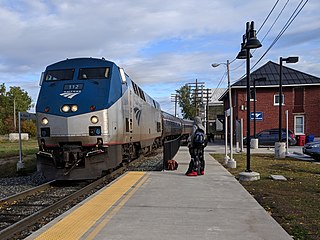
The Vermonter is a passenger train operated by Amtrak between St. Albans, Vermont, and Washington, D.C., via New York City. It replaced the overnight Montrealer, which terminated in Montreal until 1995. Amtrak receives funding from the states of Connecticut, Massachusetts, and Vermont for Vermonter operations north of New Haven.

Springfield Union Station is a train and bus station in the Metro Center area of Springfield, Massachusetts. Constructed in 1926, Springfield Union Station is the fifth-busiest Amtrak station in the Commonwealth, and the busiest outside of Greater Boston.

The New England Central Railroad is a regional railroad in the New England region of the United States. It began operations in 1995, as the successor of the Central Vermont Railway (CV). The company was originally a subsidiary of holding company RailTex before being purchased by RailAmerica in 2000. In 2012, the company was purchased by Genesee & Wyoming, its current owner.
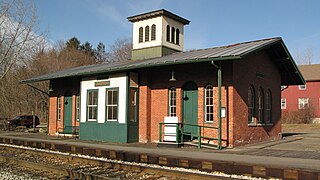
Amherst is a former intercity rail station located in Amherst, Massachusetts. The station was built by the Amherst and Belchertown Railroad in 1853; it was served by the Central Vermont Railway until 1947. Amtrak service began in 1989 with the Montrealer; it was replaced by the Vermonter in 1995. The station was closed on December 28, 2014, when the Vermonter was rerouted to the faster Connecticut River Line to the west.

Bellows Falls station is an Amtrak intercity rail station located in the Bellows Falls village of Rockingham, Vermont, United States. The station is served by the single daily round trip of the Washington, D.C.–St. Albans Vermonter. It has a single side platform adjacent to the single track of the New England Central Railroad mainline.

St. Albans station is an Amtrak train station in St. Albans, Vermont, United States. It is the northern terminus of the daily Vermonter service.
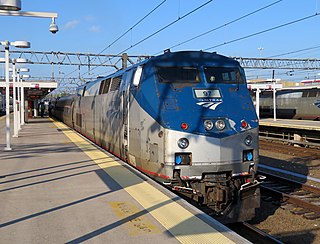
The Hartford Line is a train service run by Amtrak primarily between Springfield, Massachusetts, and New Haven, Connecticut, along Amtrak's New Haven–Springfield Line.

The Central Corridor Rail Line was a proposed passenger service route between New London, Connecticut, and Brattleboro, Vermont. A primary purpose of the proposed service was to provide a rail link between state flagship schools UConn, UMass Amherst, and UVM.

The John W. Olver Transit Center, also called the JWO Transit Center, is an intermodal transit hub for Franklin County, Massachusetts. Located in Greenfield, it currently serves Franklin Regional Transit Authority (FRTA) local bus routes plus intercity bus service. Amtrak's Greenfield station is also located here, with one daily Vermonter round trip and two daily Valley Flyer round trips, which are extensions of Amtrak-run Hartford Line trains.
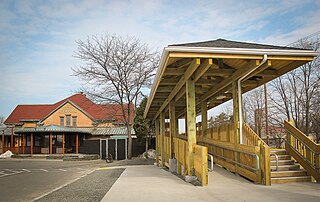
Union Station is a historic building in Northampton, Massachusetts, that served as a train station from 1897 until 1987. Built at the close of the nineteenth century, the structure incorporates many features of the Richardsonian Romanesque architectural style. The buff brick masses of the station are trimmed with red Longmeadow brownstone and hooded by red tile roofs. Steep dormers protrude from the roofline. The interior once featured Italian marble floors, oak woodwork, and a large fireplace.

Holyoke station is an Amtrak intercity train station near the corner of Main and Dwight streets in Holyoke, Massachusetts, United States. The station opened on August 27, 2015, eight months after Amtrak's Vermonter service was re-routed to the Connecticut River Line through the Pioneer Valley.
The Night Owl was a passenger train operated by Amtrak on the Northeast Corridor between Washington, D.C., and Boston, Massachusetts, via New York City. It operated from 1972 to 1995 on an overnight schedule with sleeper service; it was the only such train on the Northeast Corridor. In 1995 Amtrak dropped most individual train names from its Northeast Corridor services and the Night Owl became another NortheastDirect service, but still on an overnight schedule. Amtrak replaced it with the Twilight Shoreliner in 1997.

The Connecticut River Line is a railroad line owned by the Massachusetts Department of Transportation (MassDOT), running between Springfield and East Northfield, Massachusetts.
The Green Mountain Flyer was an international day train between Montreal, Quebec, Canada, and the Northeast United States, with sections to New York City and Boston. It was operated in cooperation between the Rutland Railroad, the Canadian National Railway and the New York Central Railroad. The train carried the number 65 running north, and number 64 running south. The Mount Royal was the night train counterpart to the Green Mountain Flyer. Following years of cutbacks, both trains were discontinued in 1953 when the Rutland Railway ended all passenger service.

The Connecticut Yankee was a long-distance train in western New England, that in its first two decades was an international night train, established in 1936, that extended from New York City into southeastern Quebec, to Sherbrooke and Quebec City, a 549-mile (884 km) trip. The pooled train covered railroad territories of the New York, New Haven and Hartford, Boston and Maine, Canadian Pacific Railway and the Quebec Central Railway. It was the last U.S.-Canadian train serving the Sherbrooke to eastern Vermont route.
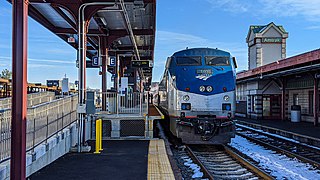
The Valley Flyer is a train service run by Amtrak between New Haven, Connecticut and Greenfield, Massachusetts along Amtrak's New Haven–Springfield Line and the Massachusetts Department of Transportation's Connecticut River Line.


















